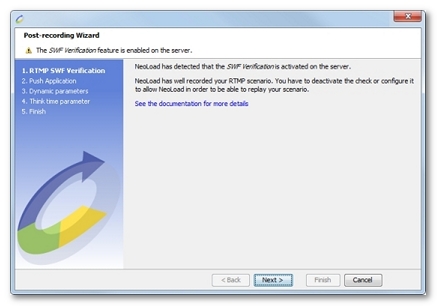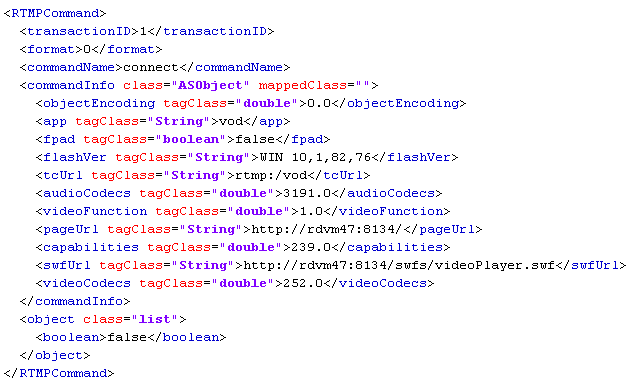SWF verification
SWF verification is a feature of RTMP servers that checks to make sure the connected client is the expected SWF file. Once the client is connected, the server sends a message to the client that must be answered with the correct signature. If the answer is invalid, the server refuses to communicate with the client.
Since NeoLoad passes itself off as a client during the scenario simulation, the server sends the verification message. However, the Adobe license that covers RTMP prohibits developing a client that can simulate this verification. NeoLoad therefore cannot send an answer to the server.
If, after recording, NeoLoad detects that SWF verification is enabled, the following message is displayed.

During runtime, if the server sends an SWF verification message, NeoLoad throws an NL-RTMP-PLUGIN-ENGINE-04 error. For NeoLoad to simulate this type of RTMP scenario correctly, SWF verification must be either disabled or configured to ignore verification for NeoLoad.
Disable SWF verification
To disable SWF verification, the application must be reconfigured. To do this, and if the configuration applies to all applications, the following file needs to be changed on the server: <Server>/conf/_defaultRoot_/_defaultVHost_/Application.xml; if the configuration applies to the specific application: <Server>/applications/<Application>/Application.xml.
Locate the following item in the configuration file:
<SWFVerification enabled="true">...</SWFVerification>
Replace enabled="true" with enabled="false" to disable SWF verification for all clients.
Ignore SWF verification for NeoLoad
To disable SWF verification for NeoLoad only, the application needs to be reconfigured. To do this, and if the configuration applies to all applications, the following file needs to be changed on the server: <Server>/conf/_defaultRoot_/_defaultVHost_/Application.xml; if the configuration applies to the specific application: <Server>/applications/<Application>/Application.xml.
Locate the following item in the configuration file:
<SWFVerification enabled="true">...</SWFVerification>
Underneath this item, locate the <UserAgentExceptions> item and add the following entry immediately underneath it:
<Exception from="NeoLoad" to="NeoLoad" />
The configuration should now look like this:
<SWFVerification enabled="true"> ... <UserAgentExceptions> ... <Exception from="NeoLoad" to="NeoLoad" /> </UserAgentExceptions> </SWFVerification>
Finally, in NeoLoad, configure the request making the connection to tell the server that the client is NeoLoad. To do this, locate the "connect" request (the name may have the format "connect_X").

Then replace:
<flashVer tagClass="String">WIN 10,1,82,76</flashVer>
with:
<flashVer tagClass="String">NeoLoad</flashVer>